Venture industry itself is risky, full of surprises and requires attention. Information is a new air, but it can be used in different ways, and sometimes might be harmful for the market. COVID-19 is a perfect example that happened only half a year ago: internet and media were overdosed with materials predicting the future of all VC industry and startups market. Eventually, all this data could influence a company with premature decisions and intensify the crisis.
That’s why it is crucially important to define and understand the media landscape. For this purpose, one of the methods of automatized linguistics is being used. It is called sentiment-analysis and together with the UN we will discover how big is its power.
Meet the basis
Sentiment-analysis already entered your life, starting from Barack Obama election campaign back in 2008. There are definitely a lot of examples even before, but Obama’s social media campaign was the first massive evidence that Twitter and Facebook posts can affect this much. Nowadays indexes of feelings are widely used in market development analysis, but there are only a few indexes for VC sphere. “European VC market sentiment index” is one of them aimed to provide information about the current situation and further development.
As social media plays a key role in society and economics, there is a lack of research covering connections between SM and private capital markets, which are sensitive to the lack of information. In 2019 this correlation was analyzed regarding startups supported by VC. The result confirms that there is a positive dependency between Twitter sentiments mentioned the most popular technologies for startups and the evaluation of these startups. These higher elevations also were discovered to be unreasonably high in the long-term perspective. It shows that even for specialized venture capitalists, there is no immunity from the social promotion of virus technologies.
Research also shows that interactions on social media can reveal extremely strong predictions about future development. For example, researchers have proved that a measure of social evaluation based on Twitter content can be used to predict the survival of new businesses. The results suggest that in 76% of cases there is a possibility to separate failed startups from survivors.
This UN research is aimed to identify new trends born of the main economic shocks of the last decade, which will allow a review of all existing long-term strategies.
Data measurement and discoveries
Let’s consider markets as a network of individuals, reacting to the news. Each person got his or her opinions and views about a particular object, and displays it on social media. These positions and opinions together form the general sentiments in the market. Using machine learning these sentiments can be separated in an overview and play an important role on VC industry.
UN analyzed 9500 Twitter accounts of key employees in 5500 venture funds. It covered 277000 publications during the first two quarters of 2020. All tweets have been cleared of unnecessary information (smiles, hyperlinks and punctuation), that can complicate the analyzer learning process. Stop-words and unification for lower case along with stemming were also done.
As a result the following tag cloud was created. It could be seen how COVID-19 became a major topic for venture investors and keywords team, people, market, technology have been pushed to the background while the majority of existing models identify these topics in their analysis as fundamental.
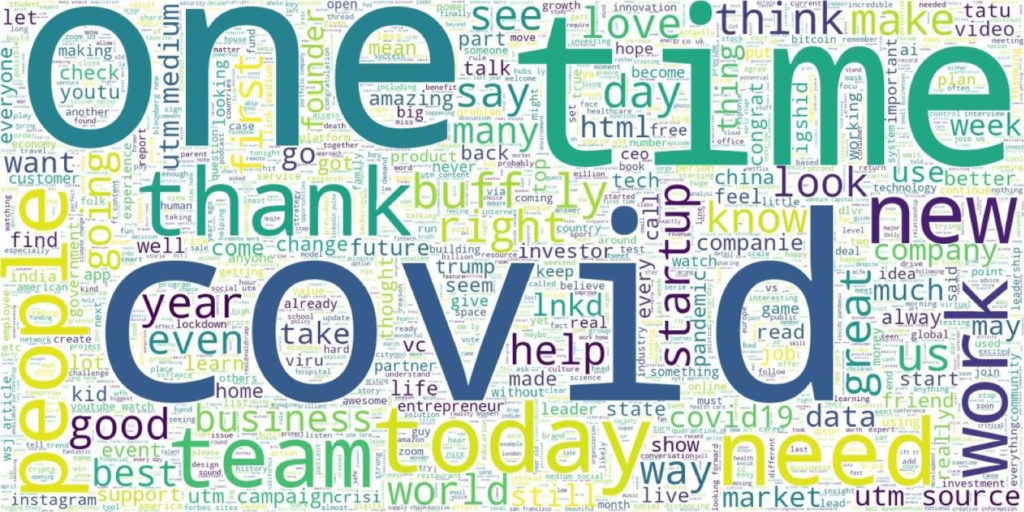
The analysis evaluated each of the publications for emotionality on a scale from -1 to 1, where -1 is the most negative text, and 1 is the most positive.
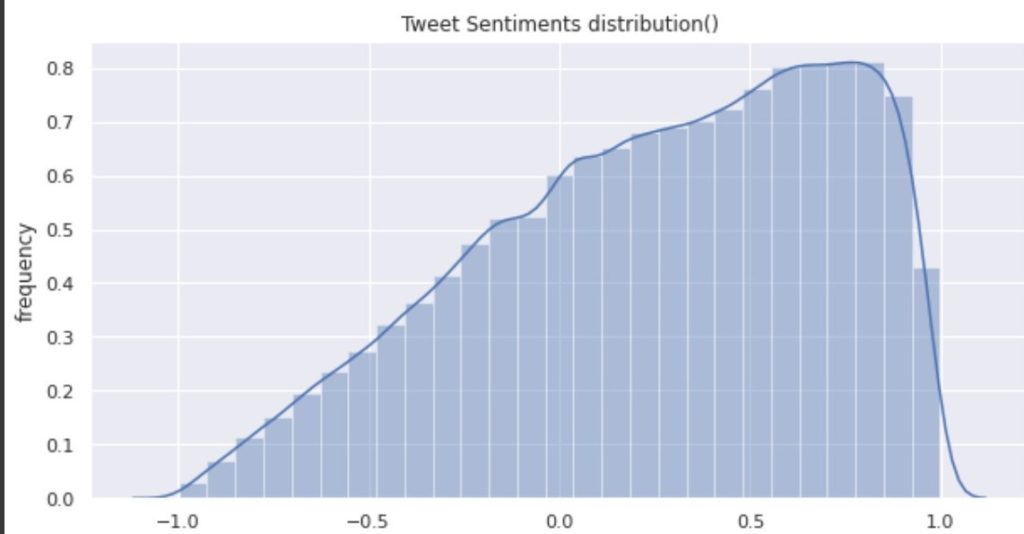
The distribution is negatively beveled with a long left tail. It can be explained with neural network data specification – there were a lot of jokes and sarcasm, which were classified as a positive reaction. Besides, researched period was full of holidays, such as New Year, St. Valentine’s day, etc.
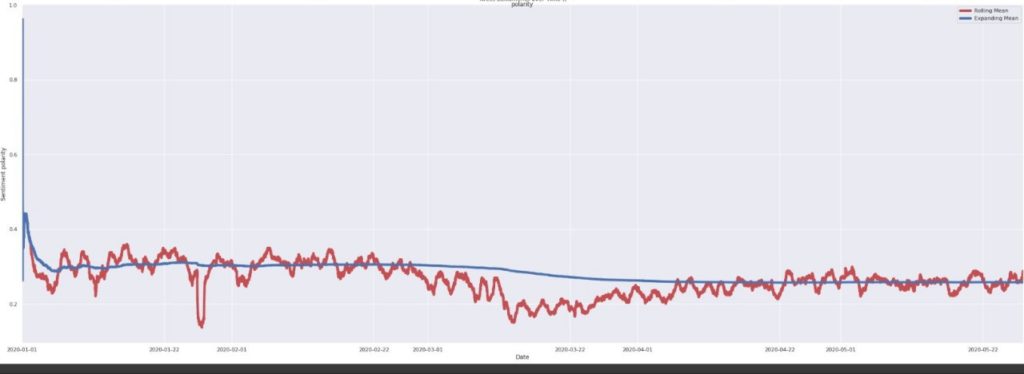
The changes of the average daily emotional context can be clearly seen on tweets starting after January 22, 2020, when the Chinese city of Wuhan was closed for quarantine. The next drop came after January 30, when the WHO declared the new coronavirus outbreak a health emergency of international importance. As all the cases described above quickly lost their negative footprint, after March 13, when Europe became the center of the outbreak, the trend failed to return to pre-pandemic levels. Positive tweets increased valuably on April 24, after the WHO made a statement confirming outbreaks in Western Europe are becoming stable or decreasing. However, there is also a clear impact of non-pandemic events, such as the surge of positive tweets on April 1.
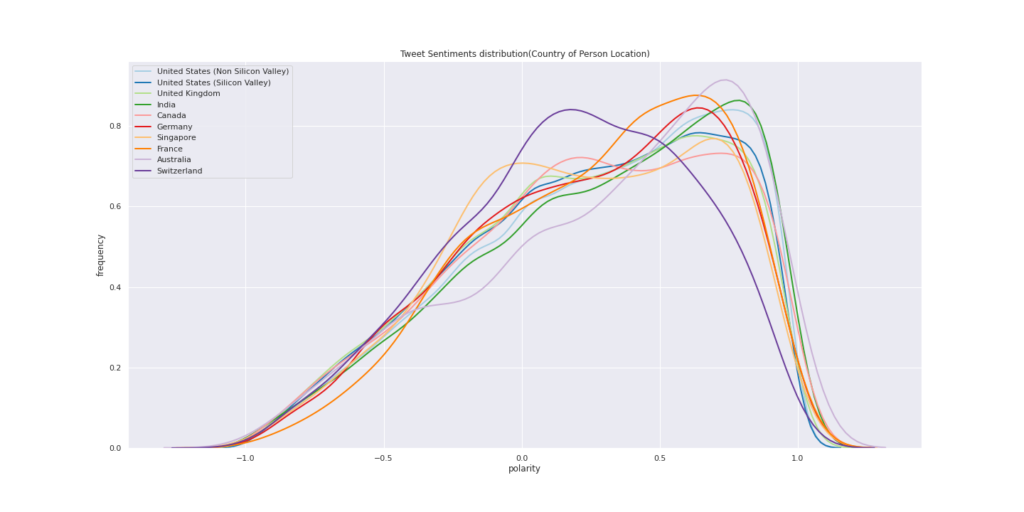
UN also analyzed sentiments from top-10 countries of VC funds employees locating. For most of them, including SV USA, USA, Great Britain, Canada, India, Germany, Singapore, France, Australia and Switzerland there is a common trend of emotional tweet peaks with Great Britain having the smoothest allocation and Australia having the sharpest. India turned out to be most positive and SV USA tweeted the most negative way. Outside the Silicon Valley USA is in a top-list for positive sentiments. Among the countries that are knocked out of the typical picture Switzerland should be mentioned with its result close to 0.
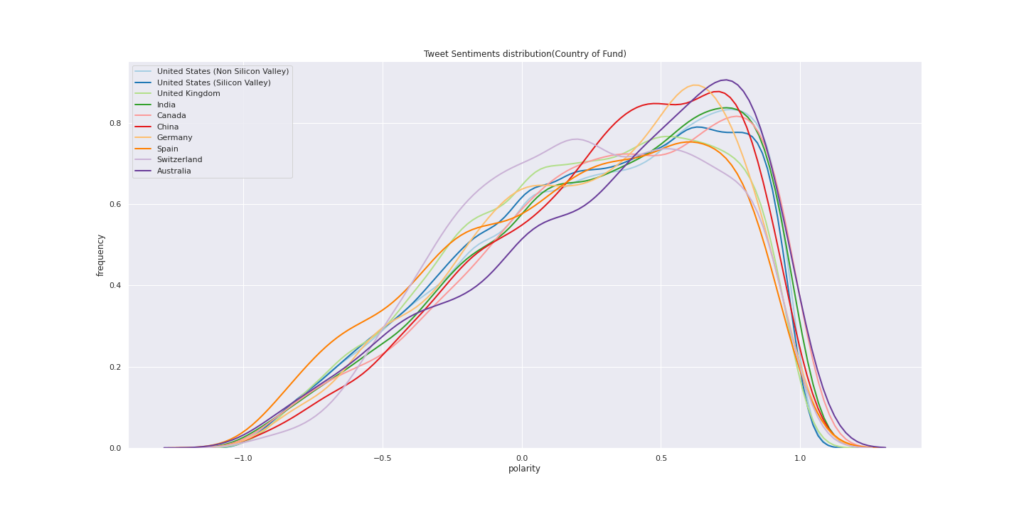
The selection of tweets by countries where headquarters is located has a much greater uniformity of results. This comparison suggests that a person's emotions are much more influenced by the geography of his head office, rather than personal location. Thus, the emotional response to information from the environment is not as high as to information coming from professional communication channels. The highest and lowest peaks are in Australia and Spain. The most positive tweets are found in publications from Canada, and the most negative - from Switzerland, which in the previous schedule had a similar trend, but with an extreme margin.
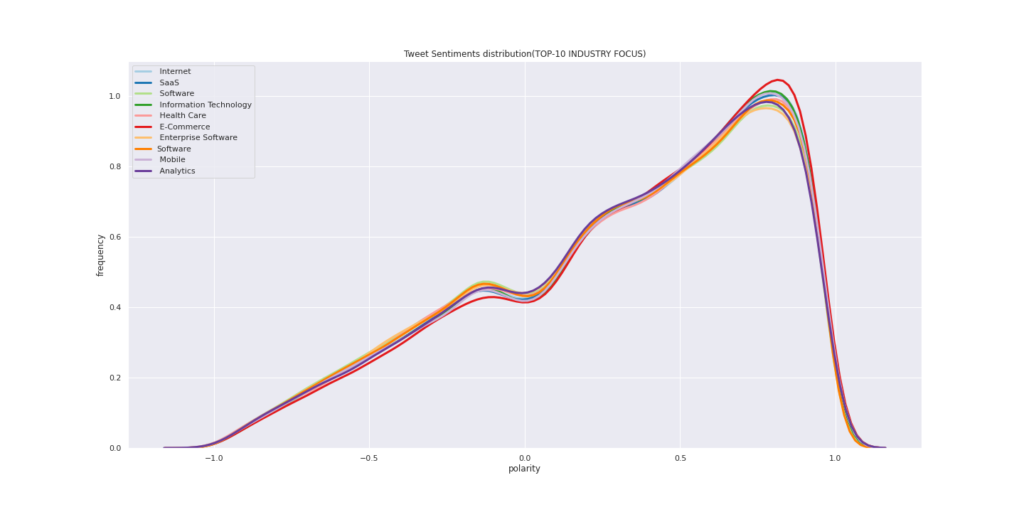
The research also showed that regardless of the main area of investment, people have almost the same emotional color of their publications. Only investors in the e-retail sphere have a difference with a peak noticeably higher than others. This can be explained by the industry's greatest growth due to COVID-19 pandemic with offline trade pause.
Regardless of the predominant focus on the stage of investment, investors and VC-funds employees have the same trend in sentiments allocation. However, seed and early investment stages tend to be more negative, which indicates that people are less prepared for the pandemic crisis situation.
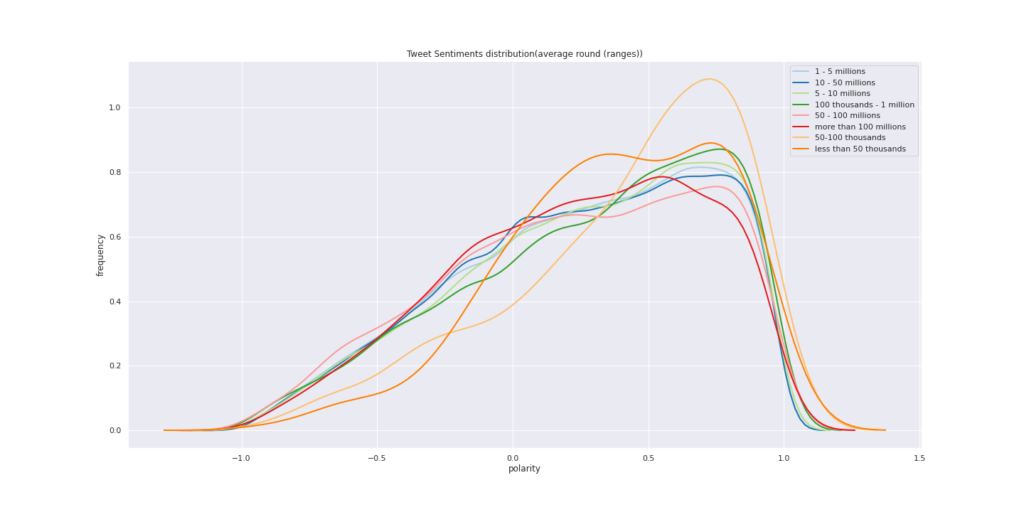
Research in the correlation between tweet sentiments and investment checks found that investors working with the smallest checks were more turbulent. The most negative were the publications of investors who invested the smallest of the presented ranges, up to 50 thousand US dollars, and the largest peak, which stands out from the overall picture, in the next segment - from 50 to 100 thousand US dollars.
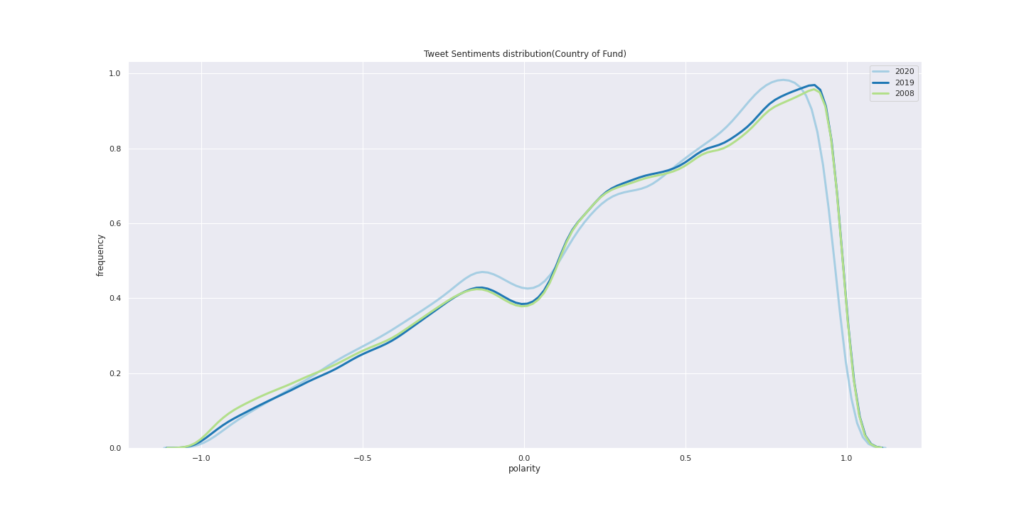
In order to make this research full, UN additionally analyzed 550 thousand Twitter-posts for the same periods in 2019 and 2008. It confirmed COVID-19 impact on the emotional status of the industry, as comparing to 2019 same period 2020 tweets are 11% more negative.
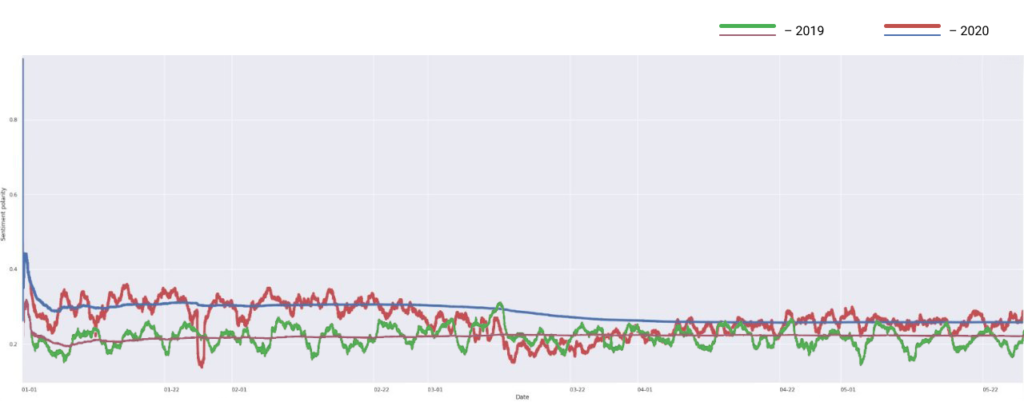
A more significant difference between the sentiments of 2019 and 2020 is shown on a chart above – 2019 trend line of 2019 is horizontal, all fluctuations have only a weekly cycle, compared to 2020 sharp dynamics responding to year difficulties.
What’s next?
Venture capital is an industry full of asymmetric information, so market players should realize how their information footprint can influence all markets and sometimes may cause panic and turbulence. The UN research has discovered that the crisis affects investors and makes them be more emotional. Eventually it interferes with a critical perception of the situation and increases the chances of making a mistake.
Based on the results of various sections of the analysis, investors and startups can change their strategies during the crisis, adjusting the emotionality factor in their geography, industry or stage of investment

